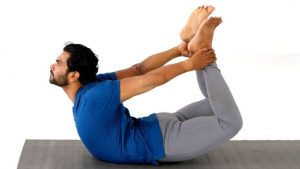OBESITY – YOGA ASANAS
- December 20, 2022
- Posted by Dr. Vaidya Karanvir Singh
- 0 Comment(s)
Table of Contents
INTRODUCTION
Obesity is a complex and chronic disorder which is associated with excessive amount of fat on body. A BMI (body mass index) of 30 or more is considered to be onset of obesity in adults. A BMI of 40 or more comes under severe obesity. Bad eating habits, genetics and lack of physical activity are the most common causes of obesity. It is not just a cosmetic concern but can lead to various other health related disorders like diabetes, heart problems, cancer, etc. Body with extra amount of fat has to do more work which leads to progressive changes which worsen overtime and causes various adverse effects.
However, it is difficult to lose weight but a moderate reduction in body weight can prevent various health problems. Healthy diet and regular exercise can help a person in losing weight. There are also various medicines and weight-loss procedures for treating it.
WHAT ARE THE VARIOUS CAUSES OF OBESITY?
When a person eats more calories in comparison to how much he burns, then he tends to gain weight. On a long term basis, these extra calories lead to obesity. However, this is the main reason but there are various other reasons also. The specific causes of obesity are:
- Having a genetic predisposition to obesity
- Increasing age as the rate of metabolism slows down
- Lack of sleep
- Pregnancy
- Polycystic ovarian syndrome
- Cushing syndrome
- Hypothyroidism
- Osteoarthritis that leads to reduced physical activity
SOME OF THE RISK FACTORS OF OBESITY
Some factors increase a risk of person developing obesity. Following are the risk factors:
- Smoking
- Alcohol intake
- Environmental factors
- Physical or emotional stress
- Hormonal imbalance
- Certain medications like anti-depressants, steroids, etc
- Any physical trauma
- Depression
WHAT ARE THE SYMPTOMS OF OBESITY?
Increase in body mass is the most common symptom of obesity. But it is often related to other metabolic symptoms. Men having a waist circumference of 40 inches or more and women having a waist circumference of 35 inches or more develop health related disorders to obesity. Following are the obesity related health problems:
- Insulin resistance
- Diabetes
- Chronic inflammation
- Coronary artery disease
- Fatty liver
- Cirrhosis of liver
- Inflammation of gall bladder
- Kidney stones
- Stroke
- Heart attack
- Heart failure
- Asthma
- Sleep apnea
- Osteoarthritis
- Pain in back
- Gout
YOGA FOR OBESITY
Yoga is very beneficial for getting rid of obesity. It helps in burning extra amount of body fat and helps in toning of muscles. If performed daily, it helps in keeping mind and body healthy. Following are the yoga asanas which are very beneficial for getting a fit body from fat body:
DHANURASANA
Dhanu means bow and asana means body posture. In dhanurasana, the shape of the body is made like that of a bow. The pose should be performed 4-5 hour after meals. The best time is of early morning.
How to do it:
- Lie in the stomach with the feet apart.
- Then fold the knees and take your hands backwards and hold the ankles.
- Breathe in and lift the chest up from the ground. Pull the legs upwards and more towards the back.
- Keep the body posture stable and see forward. Pay attention to the breath.
- Maintain posture for 15-20 seconds and bring the legs and chest gently to the ground.
Contraindications:
- Neck injury
- Hernia
- Hypertension or hypotension
- Lower back pain
- Migraine
- Recent abdominal surgery
SARVANGASANA
Sarvangasana is also known as shoulder stand. It is a yoga pose in which the whole body is balanced on the shoulders. Sarv means all, anga means a part of body and asana means body posture. It has an influence on the functioning of all the body parts. This asana is known as Queen of the asanas. It is very beneficial for maintaining physical and mental health.
How to do it:
- Lie on the back with hands on the side
- Then, with one movement, lift the legs, buttocks and back so that their weight comes on the shoulders. Support the back with both the hands.
- Keep the legs and spine straight with the help of elbows and hands to the back. The weight should be supported on shoulders and upper arms not on head and neck.
- Breathe deeply while maintaining the posture for 30-60 seconds.
- Then, lower the knees to forehead and bring your hands down to the floor. Without lifting the head, bring the spine down. Lower the legs on the floor and relax for a minimum of 60 seconds.
Contraindications:
- Pregnancy
- Menstruation
- Hypertension
- Glaucoma
- Slip disc
- Neck pain
- Spondylosis
KAPALBHATI PRANAYAM
Kapalbhati pranayam is a breath conscious yoga practice. It helps in strengthening immune system of body and keeps our body and mind healthy. Bu regularizing our breath, the stress hormone of the body decreases and excessive acid production is reduced.
How to do it:
- Sit in a straight posture with spine erect and place the hands on knees with palms open.
- Then take a deep breath in and exhale. During exhalation, pull the navel inwards as much as a person feels comfortable.
- As the navel and abdomen relaxes, the air flows in deeply.
- One should take 20 rounds of breath to complete one round of kapalbhati.
USTRASANA
Ustra means camel and asana means body posture. It is a very beneficial pose of back problems but if done regularly, it can help in management of acidity also. It increases digestion of body.
How to do it:
- Kneel on the yoga mat and place the hands on hips.
- Knees should be aligned with the shoulder and soles of feet should face ceiling.
- Arch the back and place the palms on soles.
- Neck should not be strained and kept in neutral position.
- Maintain the posture for a couple of breaths and then slowly come to the initial position.
Contraindications:
- Hypertension
- Low blood pressure
- Back injury
- Injury of the neck

Dr. Vaidya Karanvir Singh is the younger Vaidya in Chandigarh Ayurved & Panchakarma Centre. He is the fourth generation in his family who is practicing as a general consultant in Ayurved & Panchakarma treatment at Chandigarh. In his practice, he had treated more than 1 Lakh Plus patients worldwide.





